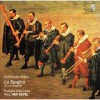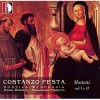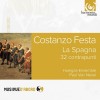| Country: | Italy |
| Period: | Renaissance |
Biography
Costanzo Festa (ca. 1485–1490 – 10 April 1545) was an Italian composer of the Renaissance. While he is best known for his madrigals, he also wrote sacred vocal music. He was the first native Italian polyphonist of international renown, and with Philippe Verdelot, one of the first to write madrigals, in the infancy of that most popular of all sixteenth-century Italian musical forms.
Not much is known about his early life. He was probably born in the Piedmont near Turin, but the evidence for this is not certain, being based mainly on later documents referring to him as a clericis secularibus, i.e. not a monk, from that region. His birth date has been given as early as 1480 and as late as 1495, but recent scholarship has tended to narrow the range to the late 1480s.[1] In addition he may have been related to his slightly younger contemporary Sebastiano Festa, another early madrigal composer, also from the same region. Sebastiano's father, Jacobinus, was resident in Turin around 1520.[2]
In early 1514, Festa wrote a motet, Quis dabit oculis, on the occasion of the death of the Queen of France (Anne of Brittany) (9 January 1514). Anne's funeral was an extensive affair, lasting 40 days; Johannes Prioris also composed music for it. This motet is the earliest datable composition of Festa's, and the first record of his activity.[1]
In 1514, Festa visited Ferrara, bringing some motets with him; he seems to have been an established composer by this time, as indicated by the reception he received. This motet appears in a manuscript copied between 1516 and 1519, which also contains music by Sebastiano Festa, his possible relative; since the manuscript is thought to have been copied in northeast Italy, one or more of the motets it contains may have been those he brought to Ferrara. Most likely after his visit to Ferrara, but certainly between 1510 and 1517 he lived on Ischia, an island in the bay of Naples, where he served as a music teacher to the aristocratic d'Avalos family.[1] In 1517 he moved to Rome and began employment with Pope Leo X as a singer, and his association with the Sistine Chapel choir was to continue uninterrupted for almost 30 years. In September 1536, he wrote to Filippo Strozzi, his patron, to help him find a Venetian printer willing to print a book of his liturgical music similar to the ones being printed in Rome by Andrea Antico; he wanted the sum of 200 scudi for the job, but was unsuccessful. During this era, printers more often demanded money from composers for the privilege of publication than the other way around.[3]
Festa was active as a composer throughout the period, and some of the earliest madrigals identifiable as such, by any composer, may come from his pen and date from the mid 1520s; only some compositions by Bernardo Pisano, Sebastiano Festa, and possibly Philippe Verdelot may predate them by a few years.[1][4] While he was unsuccessful in his attempted sale to the Venetian printer in 1536, a Roman firm produced a book of madrigals in 1538 as a result of the privilege granted, but most of it has been lost. In 1537, a Venetian firm printed a collection of his madrigals for three voices.[1]
An unusual number of Festa's works can be dated precisely, since some of the compositions are topical, referring to weddings, visits, deaths, and other events (some composers of the Renaissance, such as Josquin des Prez, wrote an immense amount of music, almost none of which can be dated precisely).[1] Among the dateable compositions is the motet for Anne of Brittany; compositions copied in a manuscript between 1515 and 1519; a motet protesting the 1527 sack of Rome; some madrigals Festa sent to Strozzi in 1528 (they were named "canti"); a lost 1533 madrigal to a poem by Michelangelo; music for a 1539 Medici wedding; and other compositions in hand-written manuscripts which have been dated.[1]
A communication from 1543 indicates that Festa was too sick to travel with the Pope to Bologna, and he died in Rome in 1545.









